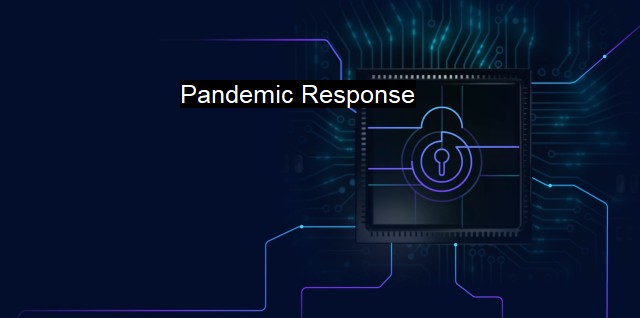What is Pandemic Response?
The Vital Importance of Cybersecurity in Our Increasingly Digital World: Insights on Pandemic Response and Strategies for Mitigating Cyber Threats
Pandemic Response in the context of cybersecurity and antivirus refers to the collective measures, strategies, and activities that organizations and countries put in place to deal with widespread cyber-attacks and infections. Just like a biological pandemic, which at its core involves a disease going beyond control, a cyber "pandemic" signifies a situation wherein a specific malware (computer virus, ransomware, worm, trojan, etc.) spreads uncontrollably across large-scale computer networks, regardless of national boundaries.Traditional antivirus measures are often put on standby to detect and respond to threats based on identified signatures. with malware authors continually developing novel techniques to evade detection, this strategy proves stagnant. Here is where pandemic response plays a crucial role. It leverages improved techniques, including behavioral analysis, sandboxing, machine learning, and artificial intelligence, to identify and neutralize threats even when attacker methodologies remain unknown.
In the face of sophisticated and potential global-scale cyber threats, proactive measures are necessary. A solid pandemic response infrastructure warrants requisite risk analysis, threat intelligence gathering, and fuse information with international cooperation. Thus, there are multi-level and multi-faceted layers of activities under pandemic response:
Firstly, this incorporates the use of more sophisticated and comprehensive defense mechanisms than classic antivirus tools. Advanced solutions such as Next-Generation Antivirus (NGAV) and Endpoint Detection and Response (EDR) tools enhance detection capabilities to go beyond malware signatures. These advanced tools monitor network behaviors and flag any suspicious activities or anomalies that may indicate an intrusion even before a full-fledged attack occurs.
Proactive threat hunting anchors an effective pandemic response strategy. Threat hunting involves actively looking for traces of attackers within networks rather than waiting for alerts. Using the latest technology enabled by AI and machine learning, it helps in identifying subtle signs of compromise, even those by state-sponsored actors using advanced and novel techniques.
Another vital aspect circling pandemic response is the advancement of global cooperative initiatives to prevent, defend and mitigate cyber threats. In an increasingly interconnected digital landscape, no entity or country can afford to work in silos. Breakdown of information silos through facilitating international information sharing can play a pivotal role in stepping up the warn system.
Pandemic response also involves mitigation measures once an attack has transpired, including re-enforcing affected systems and damage control. Incident response teams play a critical role here, tasked with not just remediating threats but also busting attack chains. The teams deliberately tread the paths attackers walked through, gaining detailed insights and understanding of the attack, incorporating those learnings into strengthening defenses.
Particularly, during a pandemic, where shifts such as mass remote working create potential for increased cyber vulnerabilities, the role of pandemic response grows magnificently vital in ensuring continuity, integrity, and resilience of not just organizations, but at sectoral and national levels.
Lastly, continual learning and training form an indispensable part of a pandemic response. It encompasses regular simulations of cyberattack scenarios and relevant response measures by cybersecurity professionals. Similarly, non-technical staff should also undergo cybersecurity awareness training to adopt best practices and stay informed about the latest threat profiles.
Pandemic response in the context of cybersecurity is a comprehensive approach that deals with potential large-scale cyber threats. Anchoring such a strategy is a call to action given the expanding digital landscape and the continuously evolving cyber threat profiles - a call for vigilance, continual evolution, and world-wide cooperation.

Pandemic Response FAQs
What is pandemic response in the context of cybersecurity and antivirus?
Pandemic response in the context of cybersecurity and antivirus refers to the strategies and measures taken to mitigate the spread and impact of cyber threats that are posing a threat to networks and devices globally. It involves implementing security measures to detect, prevent and respond to attacks, as well as providing ongoing education and awareness to end-users on how to stay safe and secure online.What are some common pandemic response measures for cybersecurity and antivirus?
Some common pandemic response measures for cybersecurity and antivirus include implementing multi-factor authentication, using firewalls and antivirus software, backing up data regularly, conducting regular security assessments and audits, and creating and enforcing strong password policies.Why is pandemic response important in cybersecurity and antivirus?
Pandemic response is important in cybersecurity and antivirus because it helps organizations to detect and respond to emerging cyber threats in a timely manner, safeguard their networks and devices, and minimize the risk of data breaches and financial losses. It also helps to ensure compliance with regulatory requirements and industry standards.How can employees contribute to pandemic response efforts in cybersecurity and antivirus?
Employees can contribute to pandemic response efforts in cybersecurity and antivirus by following best practices for cyber hygiene, such as keeping their software and devices up to date, creating strong passwords and never sharing them, avoiding clicking on suspicious links or opening unknown attachments, reporting suspicious activity to IT or security teams, and attending cybersecurity awareness training regularly.| | A | | | B | | | C | | | D | | | E | | | F | | | G | | | H | | | I | | | J | | | K | | | L | | | M | |
| | N | | | O | | | P | | | Q | | | R | | | S | | | T | | | U | | | V | | | W | | | X | | | Y | | | Z | |
| | 1 | | | 2 | | | 3 | | | 4 | | | 7 | | | 8 | | |||||||